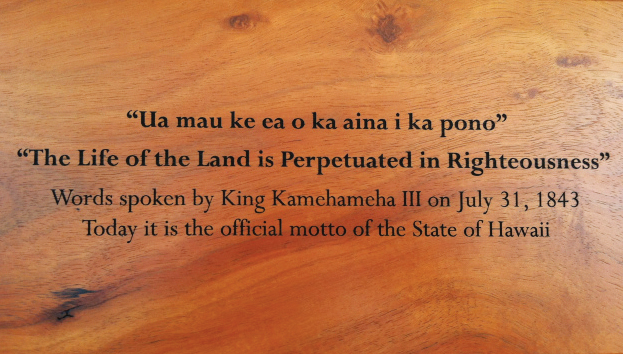In 1827, a small group of Catholics from France arrived in Honolulu to establish a mission. Within two years, they had cultivated a flock of 65 followers. This seemingly benign event triggered a series of hostile confrontations with France and Britain, and an awareness of Hawai‘i’s precarious position, paving the way for the adoption of Western-style laws and formal recognition of its sovereignty.
France and the Catholics
- The ali‘i that embraced the Protestant faith looked upon the Catholic priests with suspicion and disfavor. Their influence was seen as divisive to a community that was largely Protestant. In 1829, O‘ahu Governor Boki forbade Hawaiians from attending Catholic worship and Ka‘ahumanu sentenced believers to forced labor. The Catholic priests were later expelled, but others arrived in their place.
- The Laplace Affair. The 60-gun French frigate, Artémise, sailed into Honolulu Harbor on July 9, 1839. Captain Laplace demanded to meet with the king to press for religious freedom for Catholics. He forced Kauikeaouli (Kamehameha III) to sign an unfair treaty and pay $20,000 as insurance.
— Captain Cyrille Laplace, Captain of Artémise5
- The treaty granted freedom of worship to Catholics and special trade privileges to France. The Laplace affair reinforced how vulnerable Hawai‘i was to foreign manipulation and takeover. (Soon afterward, France took possession of the Marquesas Islands and Tahiti, and Britain annexed New Zealand.) The treaty also created a privileged alliance with France that upset trade relationships with both America and Britain.
Britain and Annexation
- British consul Richard Charlton agitated for Hawai‘i’s annexation. He and others wanted desperately to overturn America’s dominance in commercial and missionary affairs. “During the fall of 1842 and the first weeks of 1843, many people shared the belief that the islands would soon be seized by one of the great European powers.”6
- The Paulet Affair. Consul Charlton flooded the British and Hawaiian governments with claims that the rights of British citizens were being trampled by the Hawaiian government. On Feb. 10, 1843, Lord George Paulet of HMS frigate, Carysfort, arrived in Honolulu. He demanded that the rights of British citizens be restored, upon immediate threat of war. Kauikeaouli signed a provisional cession to Great Britain, placing the nation under temporary British authority. Hawai‘i remained under British rule for five months.
- Britain sent Admiral Richard Thomas to investigate the Paulet affair and, on the morning of July 31, 1843, he restored Hawai‘i’s independence. Thomas Square in Honolulu, where the restoration ceremony took place, is named in his honor. A service of thanks was held at Kawaiaha‘o Church that afternoon, during which Kauikeaouli pronounced, “Ua mau ke ea o ka aina i ka pono,” (the life of the land is preserved in righteousness), which became Hawai‘i’s motto. The King affirmed that, from now on, Hawai‘i would be governed by the constitution and laws.
— Kauikeaouli to his followers on the provisional cession to Great Britain7
— Elizabeth Kīna‘u Wilder, from her memoirs8
5 Stevens, John Leavitt and Oleson, William Brewster, Riches and Marvels of Hawaii: A Charming Description of Her Unique History, Edgewood Publishing Company, Philadelphia, 1900, p. 234.
6 Kuykendall, The Hawaiian Kingdom, p. 213
7 Ibid., p. 216.
8 Richards, Mary Atherton, The Chiefs’ Children’s School, first published by Honolulu Star-Bulletin, Honolulu, 1937, p. 169.




